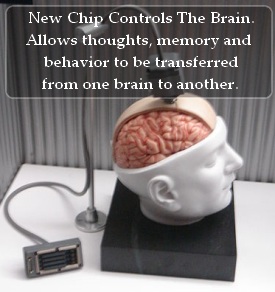Scientists working at the University of Southern California, home of the Department of Homeland Security’s National Center for Risk and Economic Analysis of Terrorism Events, have created an artificial memory system that allows thoughts, memories and learned behavior to be transferred from one brain to another.
Alexander Higgins, Contributing Writer
Activist Post
In a scene right out of a George Orwell novel, a team of scientists working in the fields of “neural engineering” and “Biomimetic MicroElectronic Systems” have successfully created a chip that controls the brain and can be used as a storage device for long-term memories. In studies the scientists have been able to record, download and transfer memories into other hosts with the same chip implanted. The advancement in technology brings the world one step closer to a global police state and the reality of absolute mind control.
More terrifying is the potential for implementation of what was only a science fiction fantasy – the “Thought Police” – where the government reads people’s memories and thoughts and can then rehabilitate them through torture before they ever even commit a crime based on a statistical computer analysis showing people with certain types of thoughts are likely to commit a certain type of crime in the future.
We already pre-emptively invade nations and torture alleged terrorist suspects with absolutely no due process of law, so the idea of pre-emptively torturing a terrorist suspect beforehand to prevent them from committing an act of terrorism in the future really isn’t that far fetched of an idea.
Perhaps a less sensational example than those I just depicted from Orwell’s famous dystopian novels would be using the technology as it is depicted the modern day Matrix movies, in which computer programs are uploaded into people’s brains allowing them to instantly learn how to perform a wide variety of tasks.
That is exactly the example that Smart Planet uses in their write-up on the USC press release.
The Matrix reality: Scientists successfully implant artificial memory system
It seems the sci-fi industry has done it again. Predictions made in novels like Johnny Mnemonic and Neuromancer back in the 1980s of neural implants linking our brains to machines have become a reality.
Back then it seemed unthinkable that we’d ever have megabytes stashed in our brain as Keanu Reeves’ character Johnny Mnemonic did in the movie based on William Gibson’s novel. Or that The Matrix character Neo could have martial arts abilities uploaded to his brain, making famous the line, “I know Kung Fu.” (Why Keanu Reeves became the poster boy of sci-fi movies, I’ll never know.) But today we have macaque monkeys that can control a robotic arm with thoughts alone. We have paraplegics given the ability to control computer cursors and wheelchairs with their brain waves. Of course this is about the brain controlling a device. But what about the other direction where we might have a device amplifying the brain? While the cochlear implant might be the best known device of this sort, scientists have been working on brain implants with the goal to enhance memory. This sort of breakthrough could lead to building a neural prosthesis to help stroke victims or those with Alzheimer’s. Or at the extreme, think uploading Kung Fu talent into our brains.
Decade-long work led by Theodore Berger at University of Southern California, in collaboration with teams from Wake Forest University, has provided a big step in the direction of artificial working memory. Their study is finally published today in the Journal of Neural Engineering. A microchip implanted into a rat’s brain can take on the role of the hippocampus—the area responsible for long-term memories—encoding memory brain wave patterns and then sending that same electrical pattern of signals through the brain. Back in 2008, Berger told Scientific American, that if the brain patterns for the sentence, “See Spot Run,” or even an entire book could be deciphered, then we might make uploading instructions to the brain a reality. “The kinds of examples [the U.S. Department of Defense] likes to typically use are coded information for flying an F-15,” Berger is quoted in the article as saying.
[…]
In this current study the scientists had rats learn a task, pressing one of two levers to receive a sip of water. Scientists inserted a microchip into the rat’s brain, with wires threaded into their hippocampus. Here the chip recorded electrical patterns from two specific areas labeled CA1 and CA3 that work together to learn and store the new information of which lever to press to get water. Scientists then shut down CA1 with a drug. And built an artificial hippocampal part that could duplicate such electrical patterns between CA1 and CA3, and inserted it into the rat’s brain. With this artificial part, rats whose CA1 had been pharmacologically blocked, could still encode long-term memories. And in those rats who had normally functioning CA1, the new implant extended the length of time a memory could be held.
[…]
Source: Smart Planet
The Smart Planet article goes on to point out that the next phase in testing will be done on primates and will eventually be tested on humans.
From the USC press release:
USC: Restoring Memory, Repairing Damaged Brains
Biomedical engineers analyze—and duplicate—the neural mechanism of learning in rats
LOS ANGELES, June 17, 2011 /PRNewswire-USNewswire/
Scientists have developed a way to turn memories on and off—literally with the flip of a switch.
(Image Information)For stroke or Alzheimer’s victims, the promise of Dr. Theodore Berger’s recent breakthrough is enormous: imagine a prosthetic chip inserted in the brain that imitates the function of a brain’s damaged hippocampus (the region associated with long term memory). The current successful laboratory tests on rats, restoring long term memory at the flick of a switch, will next be duplicated in primates (monkeys) and eventually humans. (PRNewsFoto/USC Viterbi School of Engineering)
Using an electronic system that duplicates the neural signals associated with memory, they managed to replicate the brain function in rats associated with long-term learned behavior, even when the rats had been drugged to forget.
“Flip the switch on, and the rats remember. Flip it off, and the rats forget,” said Theodore Berger of the USC Viterbi School of Engineering’s Department of Biomedical Engineering.
Berger is the lead author of an article that will be published in the Journal of Neural Engineering. His team worked with scientists from Wake Forest University in the study, building on recent advances in our understanding of the brain area known as the hippocampus and its role in learning.
In the experiment, the researchers had rats learn a task, pressing one lever rather than another to receive a reward. Using embedded electrical probes, the experimental research team, led by Sam A. Deadwyler of the Wake Forest Department of Physiology and Pharmacology, recorded changes in the rat’s brain activity between the two major internal divisions of the hippocampus, known as subregions CA3 and CA1. During the learning process, the hippocampus converts short-term memory into long-term memory, the researchers prior work has shown.
“No hippocampus,” says Berger, “no long-term memory, but still short-term memory.” CA3 and CA1 interact to create long-term memory, prior research has shown.
In a dramatic demonstration, the experimenters blocked the normal neural interactions between the two areas using pharmacological agents. The previously trained rats then no longer displayed the long-term learned behavior.
“The rats still showed that they knew ‘when you press left first, then press right next time, and vice-versa,’” Berger said. “And they still knew in general to press levers for water, but they could only remember whether they had pressed left or right for 5-10 seconds.”
Using a model created by the prosthetics research team led by Berger, the teams then went further and developed an artificial hippocampal system that could duplicate the pattern of interaction between CA3-CA1 interactions.
Long-term memory capability returned to the pharmacologically blocked rats when the team activated the electronic device programmed to duplicate the memory-encoding function.
In addition, the researchers went on to show that if a prosthetic device and its associated electrodes were implanted in animals with a normal, functioning hippocampus, the device could actually strengthen the memory being generated internally in the brain and enhance the memory capability of normal rats.
“These integrated experimental modeling studies show for the first time that with sufficient information about the neural coding of memories, a neural prosthesis capable of real-time identification and manipulation of the encoding process can restore and even enhance cognitive mnemonic processes,” says the paper.
Next steps, according to Berger and Deadwyler, will be attempts to duplicate the rat results in primates (monkeys), with the aim of eventually creating prostheses that might help the human victims of Alzheimer’s disease, stroke or injury recover function.
The paper is entitled “A Cortical Neural Prosthesis for Restoring and Enhancing Memory.” Besides Deadwyler and Berger, the other authors are, from USC, BME Professor Vasilis Z. Marmarelis and Research Assistant Professor Dong Song, and from Wake Forest, Associate Professor Robert E. Hampson and Post-Doctoral Fellow Anushka Goonawardena.
Berger, who holds the David Packard Chair in Engineering, is the Director of the USC Center for Neural Engineering, Associate Director of the National Science Foundation Biomimetic MicroElectronic Systems Engineering Research Center, and a Fellow of the IEEE, the AAAS, and the AIMBE.
SOURCE USC Viterbi School of Engineering
RELATED LINKS
http://www.viterbi.usc.edu
Following the link to the University website we find the following research centers and programs associated with the school.
Programs
» Aviation Safety and Security Program
» Distance Education Network
» Masters and Professional Programs
» Globalization and International Programs
National Research Centers
» Biomimetic MicroElectronic Systems
» Center for Energy Nanoscience
» Integrated Media Systems Center
» DHS Center for Risk and Economic Analysis of Terrorism Events
» The National Center for Metropolitan Transportation Research
» Listing of Viterbi School Research Centers and Labs
This technology has potential for a wide array of applications. It could even be the breakthrough needed to create the the first long-imagined artificial intelligence network.
However, given the association between the University and the Federal Government’s Department of Homeland Security, and related studies on terrorism, which is constantly being used as an excuse to chip away at the civil liberties and constitutional rights of US citizens, my bets are the Feds will use this in the war on terror before they try using it for good.
That means the potential for misuse to enact a true Orwellian-style “thought police” and even the ability to implement complete mind control among hosts.
Perhaps an even scarier thought is what becomes of this technology when it becomes wireless?
Alexander Higgins is a Senior NJ ASP.Net Developer. If you want the latest buzz, analysis, and news without the snooze, visit his comprehensive work at Alexander Higgins Blog
linkwithin_text=’Related Articles:’




This technology is already working and its used to replicate sexual memory nocturnally as well decrease creative thinking. I’m a victim. I no longer read 3 books a week or have an heightened IQ to produce proactively a 4.0 GPA. Go US for your plight in domestic terrorism.